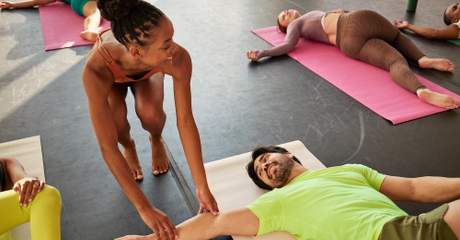What Do the Best Free Workout Apps Have in Common?
Last Updated Jan 28, 2025

Home fitness surgedis here to stay, and fitness providers are tapping this trend by creating fitness apps.
A lot, in fact — there are now over 71,000 fitness apps out there.
Especially if you already run a fitness company or wellness brand, launching an app can be a great way to expand your existing business. It’s a way to provide services to new and existing clients anywhere any time, and can drive people to your doors.
That being said, launching a free workout app is different from opening a gym.
To shorten your learning curve, here are the general best practices employed by top free exercise apps, and 10 great apps you can use as inspiration — including the key lessons each offers.
What Makes a Good Workout App?
There are 71,000 fitness apps out there, which is 71,000 case studies you can learn from. In this crowded field, a few best practices that help apps rise to the top include:
Free to Download
Paid apps are downloaded less than free apps. Only half of mobile phone users have ever even downloaded a paid app, as few people are willing to shell out cash to buy an app they haven’t tried. Free apps still generate plenty of revenue — billions of dollars, in fact — so you don’t have to require payment for download to monetize your app.
Simple Interface
Simplicity makes an app easy to use. Users will judge an app in 1/20th of a second, so a simple interface can help an app be more appealing at first glance.
Action-Oriented
Most people are not looking to apps to change the way they look at health. They’re looking to act on well-known information, like getting more sleep and veggies in your life is good for you. Apps that provide workout suggestions, nutrition ideas, and or virtual fitness classes help them take that action.
Tracking
Health apps can and should include a way for users to track their progress. A variety of progress tracking types are valuable to your users. You can include a log that tracks the nutrients your user has eaten, a chart displaying weight loss progress, or a record of the workouts the user has completed. A visual display of progress towards a goal is very motivating.
Best Free Workout Apps to Check Out
Those are general guidelines for fitness apps. But, ultimately, one of the best places to learn about what makes a great app is to look at the apps that are currently available and doing well. So let’s look at 10 fitness apps, so you can see firsthand what works.
Nike Training Club
Everyone knows Nike for their sporting gear, but they also have a great fitness app. It provides 185 free workouts in a variety of areas, from weightlifting to yoga. Fitness sessions are narrated by Nike coaches, so it’s a bit like having a trainer. Nike also offers a paid in-app subscription where the professional trainers provide specific nutrition guidance.
Key Features
- Extensive workout library
- Allows users to choose a level (beginner, intermediate, and advanced)
- Provides workout times and allows users to search by time range
- Includes time-based options and rep-based options
- Personalized workout recommendations that pop up daily
- Allows users to record other activities they do
Key Takeaways
- This app shows that an extensive workout library can be a beneficial feature.
- Personalization also goes a long way.
Adidas Training
Adidas’ training app helps users reach their fitness goals, with various workout categories, curated workout plans, an exercise library, challenges with an online community, a tracking dashboard, and premium content.
Key Features
- Allows users to track workouts in the app
- Offers a wide variety of challenges
- Compares your statistics to other competitors
- Provides personalized workouts to fit goals
- Allows users to select difficulty levels
Key Takeaway
- With many different tools and offerings, this app appeals to users who like variety in their workouts.
Adidas Runtastic
Don’t have any equipment? The Adidas Runtastic app is designed to counter that problem. The running version of Adidas’s program makes it easy to break a sweat because no equipment is required. It’s all about running and tracking your runs.
Key Features
- It makes it easy to track runs
- Compares your statistics to other competitors
- Offers a wide variety of challenges to take your runs to the next level
Key Takeaway
- This app is a great example of how focusing on just one type of exercise can still be effective and meet a real need.
FitOn
FitOn allows users to set up a profile and select what kind of workouts they like and how often they want to workout. It includes a variety of workout programs that users can choose from. FitOn also has a huge community of users, and everyone can connect with each other to provide support.
Key Features
- It connects to calendars and provides workout reminders
- Provides workout groups where members can join with members of a community
- Includes nutrition information
- Provides fitness advice
Key Takeaways
- The FitOn app shows that adding a community element can be powerful.
- Connecting with other apps (like the calendar app) can help make working out easy for your users.
MapMyFitness by Under Armour
MapMyFitness is an app that allows users to track their workouts and can connect with a wide variety of devices to help make tracking easy. Like the Nike app, this Under Armour app provides workouts narrated by Under Armour trainers.
Key Features
- Users can build their own workout routines into the app
- Easy to share workout routines with other users
- Syncs with most wearables, like Google Fit and Android Wear
- Known for having a large community of users to connect with
- Allows users to give and receive encouragement from others pursuing similar physical goals
Key Takeaway
- The Under Armour app again emphasizes the importance of having the opportunity for a community element in a fitness app. People who workout together are more motivated and more consistent, so it makes sense that community apps are well-loved.
Daily Yoga
DailyYoga focuses on its niche — at-home yoga — and provides a clear value proposition because of it. It’s part of why Daily Yoga is used by over 60 million people.
Key Features
- Offers more than 100 yoga and meditation classes
- Includes plans to reach specific goals
- Tracks progress
- Includes a variety of meditation music
- Creates a community of yogis
Key Takeaway
- Daily Yoga shows a specialized app can be very effective.
- Goal tracking and community can power user adoption and retention.
Sworkit
Speaking of specialization, the Sworkit app is known as the app for core workouts. Sworkit lets users choose from different focuses for their core—from the back to the abs to the overall core. The app includes videos of personal trainers demonstrating all of the workouts.
Key Features
- It provides 900 exercises and 500 workouts
- Provides plans to help users reach their goals
- Trainers are available for support
Key Takeaways
- The Sworkit app again shows that you can specialize in a specific workout or exercise or area of the body and create a great fitness app.
- Trainers also provide a personal touch and create a supportive environment for users.
JEFIT
The JEFIT app is a great app to look at for gyms because it’s specifically designed to be used in the gym. The app will provide plans that help users meet their goals while at the gym. A profile also includes when you like to work out and your fitness goals.
Key Features
- It includes 1,300 weightlifting workouts
- Allows users to create their own workout routines
- Syncs with Apple Health
- Tracks lifting progress
Key Takeaway
- The JEFIT app is a great example of how you can create an app that works with your gym and encourage people to come to your gym.
7 Minute Workout
The most common reason people give for not working out is the time commitment. The 7 Minute Workout app is designed to combat that problem because all of the workouts are short and sweet. It also includes video tutorials and step-by-step instructions.
Key Features
- Requires little to no equipment
- Compatible with Apple Health
- Workouts are designed to be done anywhere
- Allows users to customize their workouts
Key Takeaway
- The 7 Minute Workout combats a specific problem that’s preventing people from working out, giving it a clear value proposition.
Strava
Strava is a fitness app designed specifically for tracking distance workouts. It’s used by runners, hikers, and cyclists who want to track their distance, time, and routes. It can be used on a smartphone or connected to a smart watch. Strava also allows for groups where users can compare stats and encourage each other.
Key Features
- Great tracking capabilities
- It tracks where you workout, so you can keep track of great routes
- The app allows you to share your location real-time, so a buddy can watch out for you for your safety
- Provides community
Key Takeaways
- Strava, again, demonstrates the importance of community.
- It meets a clear, pre-existing need: keeping track of distance workouts.
Reach New Potential Gym Members
Free workout apps can be a great way to get an understanding of what works and what might be a good idea for your gym’s fitness app. Popular apps tend to be free, simple, compatible across devices, and connect users to a community.
Making an app part of your gym’s offerings can be a great way to attract new members. Another great tactic is to expand your revenue streams to corporate clients. Learn more about partnering with Wellhub!

References
- 3 Reasons to Work Out With a Friend. (July 7, 2022). Centers for Disease Control and Prevention. Retrieved February 25, 2023 from https://www.cdc.gov/diabetes/library/spotlights/workout-buddy.html.
- How People Discover, Use, and Stay Engaged With Apps. (October 2016). Think With Google. Retrieved February 25, 2023 from https://www.thinkwithgoogle.com/marketing-strategies/app-and-mobile/paid-vs-free-ap-user-statistics/.
- Lauren. (January 4, 2023). Mobile App Download Statistics & Usage Statistics. BuildFire. Retrieved February 25, 2023 from https://buildfire.com/app-statistics.
- Likarenko, Yan. How Do Free Apps Make Money. Uptech. Retrieved February 25, 2023 from https://www.uptech.team/blog/how-do-free-apps-make-money.
- Marc. (March 15, 2016). Why Simplicity Matters for Mobile App Developers. Dogtown Media. Retrieved February 25, 2023 from https://www.dogtownmedia.com/why-simplicity-matters-for-mobile-app-developers.
- Shaban, Hamza. (January 7, 2021). The Pandemic’s Home-Workout Revolution May Be Here to Stay. Washington Post. Retrieved February 25, 2023 from https://www.washingtonpost.com/road-to-recovery/2021/01/07/home-fitness-boom/.
- Spraul, Tyler. (August 25, 2020). Reasons Why People Don’t Exercise. Exercise.com. Retrieved February 25, 2023 from https://www.exercise.com/learn/why-do-people-not-exercise/.
- Wetzler, Tiahn. (July 15, 2021). Health & Fitness Apps Continue to Trend Upwards in 2021. Adjust. Retrieved February 25, 2023 from https://www.adjust.com/blog/health-fitness-apps-trend-upwards-in-2021/
Category
Share

The Wellhub Editorial Team empowers HR leaders to support worker wellbeing. Our original research, trend analyses, and helpful how-tos provide the tools they need to improve workforce wellness in today's fast-shifting professional landscape.
Subscribe
Our weekly newsletter is your source of education and inspiration to help you create a corporate wellness program that actually matters.
Subscribe
Our weekly newsletter is your source of education and inspiration to help you create a corporate wellness program that actually matters.
You May Also Like

Six Strategies to Increase Gym Membership Retention
Gym membership retention strategies can help you support each client’s wellness journey so they’re happy and engaged. You can start these methods today.

How to Increase Your Gym Memberships | Wellhub
Learn how to increase gym membership sales to grow your fitness business.

Create a Gym Marketing Plan to Boost Business
When it comes to marketing your gym, you need to create a solid game plan. Make sure you don’t forget a thing.